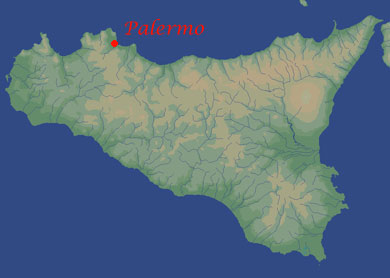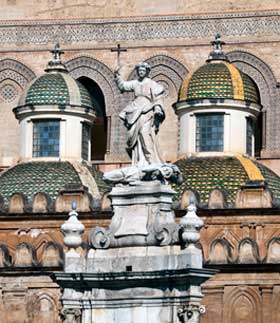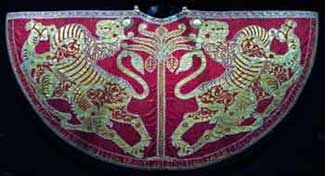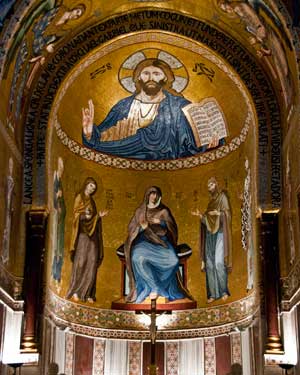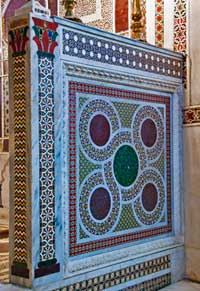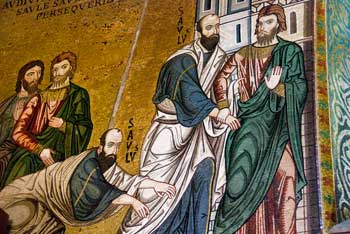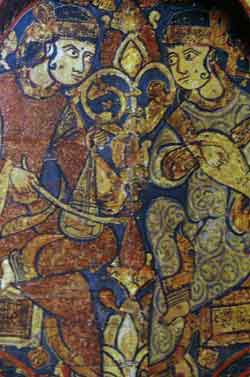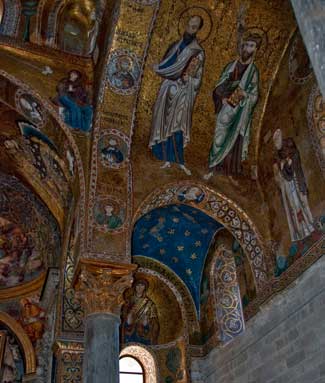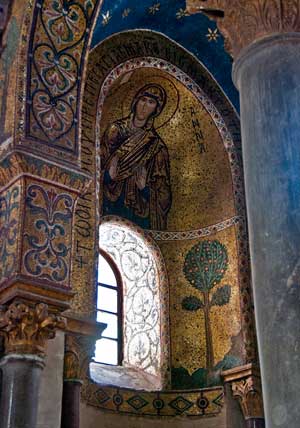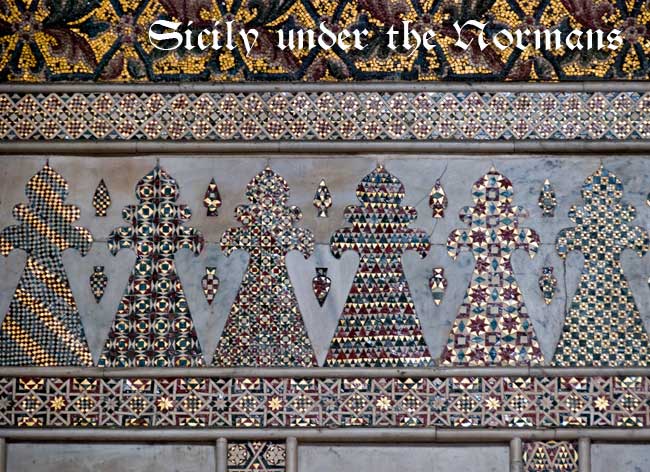
Palermo
According to tradition, the city was founded by Phoenicians from Tyre, attracted by the site’s fine natural harbour, in 734 BC. It was taken over by the Romans during the course of the course of the First Punic War (264 to 241 BC). The city flourished under Roman rule but with the collapse of the Western Empire in the fifth century AD its fortunes tumbled. In 445 it was sacked by the Vandals and eventually ended up under the control of the Ostrogoths under the rule of Theodoric. In 535 it was stormed by the forces of the Byzantine emperor Justinian.
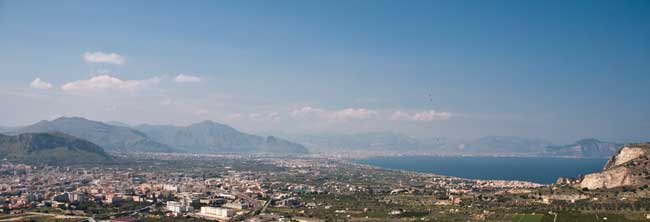
The Gulf of Palermo from Solunto
It remained under Byzantine control for the better part of the next 300 years but was eventually conquered by Arabs from North Africa, the Aghlabids, in 831. Sicily remained under Muslim rule for over 200 years, during which time Palermo became the leading city on the island and, with a population of 350,000, the second largest city (after Cordoba) in Europe. The population remained mainly Christian, however, with the vast majority of them being Greek Orthodox. In the eleventh century the island was re conquered by Christian forces, the Norman rulers of southern Italy acting on behalf of the pope. Palermo fell in 1072 and eventually became the capital of the Norman Kingdom of Sicily.
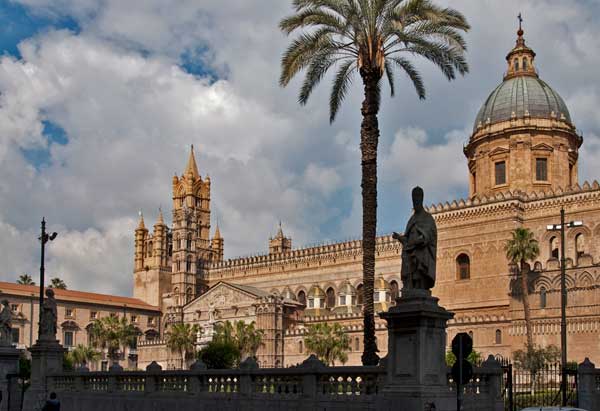
The Cathedral of Santa Maria Assunta
Probably built over the ruins of a Roman temple (which itself probably overlay a Phoenician one) the cathedral of Palermo is a bit of an architectural hodgepodge. It was built in 1185 near the site of the old Byzantine basilica but has been subject to a number of additions, renovations and reconstructions over the centuries—the latest in the eighteenth century.
The Norman Kingdom
At the end of the 11th century, while Christians and Muslims were engaged in particularly savage fighting at both ends of the Mediterranean, in the Holy Land and Spain. The Norman rulers of Sicily tried to create a more tolerant kingdom, one that utilized the talents of all their subjects whatever their religion.
The first of the new dynasty, Roger II (below left) was a member of the d’Hauteville family, the descendant of a minor baron from the Cotentin (Cherbourg Peninsula), Tancred de Hauteville (980-1041). Life was hard in that part of Normandy and it bred hard men. Unfortunately for Tancred, he bred no less than twelve of them and could only provide for one. Fortunately for the d’Hauteville brothers there were plenty of job opportunities for unscrupulous and brutal killers in southern Italy where a number of different powers—the Pope along with the Holy Roman and Byzantine emperors—contended for control of a vital region that dominated the central Mediterranean. By the middle of the eleventh century the d’Hautevilles were in control of much of the south. In 1059 Robert Guiscard (loosely translated as “the weasel”) was invested by Pope 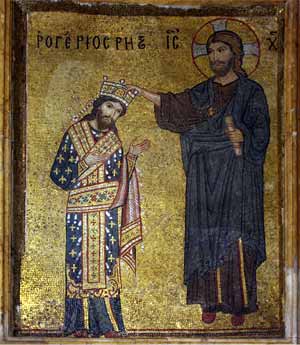 Nicholas II himself as Duke of Apulia, Calabria and Sicily. The latter title was rather meaningless, of course, because Sicily was still under the control of the Arabs.
Nicholas II himself as Duke of Apulia, Calabria and Sicily. The latter title was rather meaningless, of course, because Sicily was still under the control of the Arabs.
It took over thirty years for the d’Hautevilles to consolidate their grip over the island with the capture of Noto in 1091. By then, the Guiscard was dead and it was his youngest brother, Roger Bosso, who ruled as Count of Sicily until his death in 1101. After a brief reign by his elder brother Simon, the title passed to the nine year-old Roger II in 1105. Roger proved to be a skilful politician and by 1127 was lord of all of the d’Hauteville lands in Italy. In 1130 he backed the right horse in the papal sweepstakes and was rewarded with a throne
Roger proved to be an astute politician and a shrewd judge of character. He needed to be. Surrounded by powerful enemies, he had to use all of the resources available to him in order to survive. He took advantage of the cosmopolitan nature of Sicilian society and surrounded himself by the most learned men he could find, whether they be Roman Catholic, Greek Orthodox or Muslim. Religious tolerance was to be the founding principal of his rule. Roger was perfectly fluent in Arabic and loved Arab poetry and art. The admiral of his fleet was a Syrian Greek, George of Antioch, and Greeks played a prominent role in the highly-organized state bureaucracy. To promote this ecumenical outlook, he commissioned the construction of a number of churches and chapels, with all of his subjects playing their appropriate part.
La Cappella Palatina
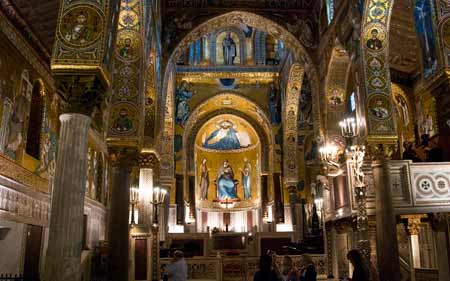
One of the most important of these was the small chapel (La Cappella Palatina) that Roger had built adjacent to his royal palace. While the floor plan is that of a typical western European Romanesque basilica—a central nave flanked by side aisles separated by a series of high, pointed arches supported by granite columns (recycled from ancient temples). The large dome over the transept was pure Byzantine, however, as were the three semi-circular apses at the ends of the nave and aisles.
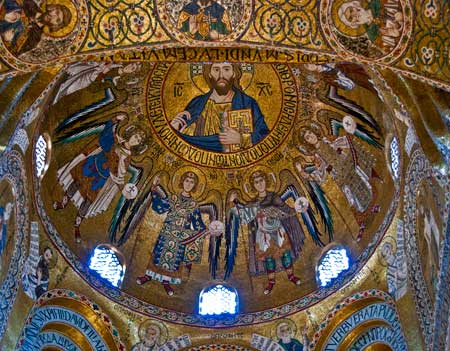
Dome of the Cappella Normanni
Also of western, specifically Italian inspiration were the rich Cosmatesque inlays that decorated the lower walls and balustrades. However, most of the decoration of the interior was predominantly Byzantine, executed by the finest mosaicists available. Their elongated proportions and subtle modulations of colour and luminance are unsurpassed. The tiles (tesserae) used to create the mosaics were made out of coloured glass. The figures were set against a background of gold mosaic tiles, each tessera composed of gold foil set between two layers of glass. These were positioned individually at just the precise angle to catch the sun at different times of the day and create a shimmering pattern of light behind each composition.
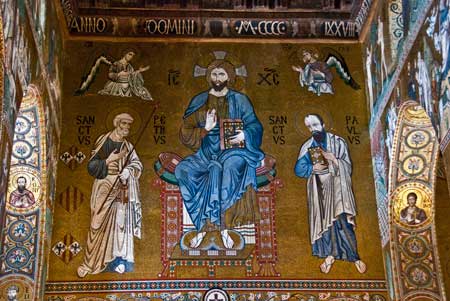
Christ flanked by Saints Peter and Paul
The oldest, probably executed in the 1140s, cover the drum and ceiling of the dome and the upper parts of the walls. They depict scenes from the New Testament—the Nativity, the life of Christ and the acts of the apostles. The latest, apparently belonging to the reign of Roger’s successor, William II, were the work of inferior craftsmen—possibly Italians from Lombardy.
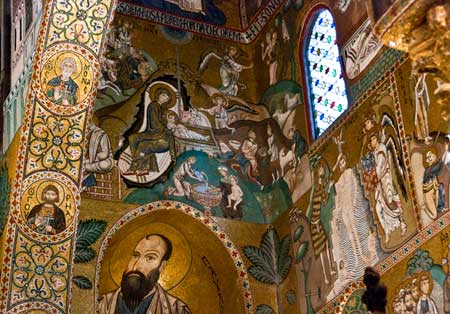
Capella Normanni. Byzantine Mosaics depicting the Nativity
The Arab contribution to the project was the magnificent ceiling of carved wood consisting of suspended quarter-domes, arches and eight pointed stars. These pendent elements are known as muqarnas and the ceiling of the nave is one of the earliest examples of the technique. The woodwork was enhanced by painted decoration that included vegetal and animal forms along with inscriptions in praise of the king. Figurative scenes, which were only just becoming acceptable in Islamic art, show people riding, hunting and picnicking . Mythological scenes including dragons and other monsters are abundant.
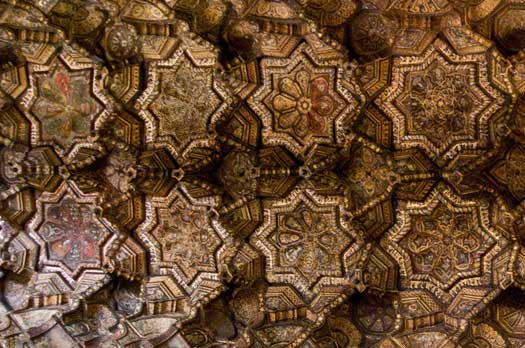
Muqarna Ceiling of the Nave
The Martorana
Roger’s admiral, George of Antioch, also used many of the same Byzantine artists and craftsmen to decorate the interior of the Greek Orthodox church that he dedicated to the Virgin Mary, the 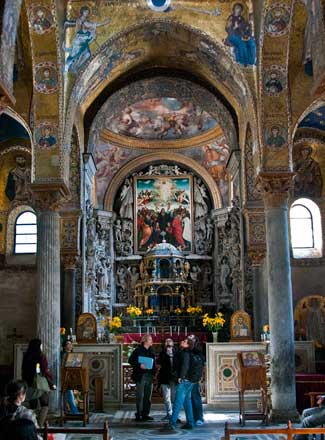 Chiesa Santa Maria dell’Ammiraglio, better known as the Martorana.
Chiesa Santa Maria dell’Ammiraglio, better known as the Martorana.
George had an amazing career. Born in Syria in Antioch, one of the largest Christian cities of the day, he moved with his parents to Tunisia where they served in the Muslim court of the local Sultan, Tamim ibn Muizz. However, George himself fell out of favour with the sultan’s son and successor, and had to flee the country in disguise. He boarded a ship bound for Palermo and immediately went into the service of the young king. Fluent in both Greek and Arabic, he rose swiftly in the diplomatic ranks and by 1127 had become commander of the Sicilian navy.
His actual title was Amir al-Bahdi, (“Emir of the Sea”) from which we derive our word “admiral.” By the time he founded the church in 1143, he had put down revolts in Apulia and Calabria, taking the cities of Bari and Amalfi in the process. In later years he added his former master’s kingdom of Tunisia to Roger’s empire. In response to the attempts of the Byzantine emperor to re-establish control over southern Italy he ravaged Greece and the Aegean, sacking the cities of Athens, Thebes (where he plundered the silk factories and carried off their Jewish weavers to kick start the industry in the West), and Athens (where he pillaged the relics of Saint Theodore). He died in 1151 or 1152 (according to Muslim chroniclers) by which time the church was finished.
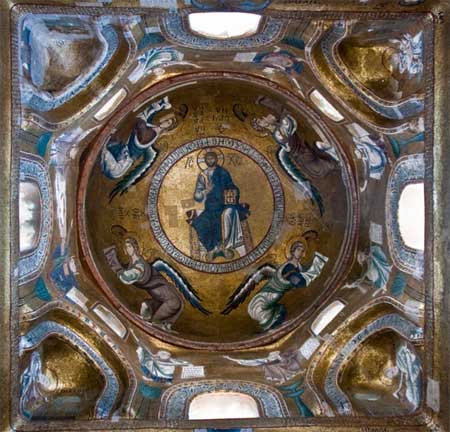
Interior of the Dome of the Martorana
The original church was a local variation on a standard Byzantine type of the day, a compact cross shape. The central part was known as the naos. It was normally square and supported a dome. Preceding it was a shallow entrance hall, known as the narthex, and beyond it was the bema, the sanctuary, which was typically triple-apsed. There were Islamic elements as well, such as the recessed niches along the outer walls. It was highly praised by the Arab traveller, Ibn Jubayr, who visited it in 1184 and described it as “the most beautiful monument in the world.”
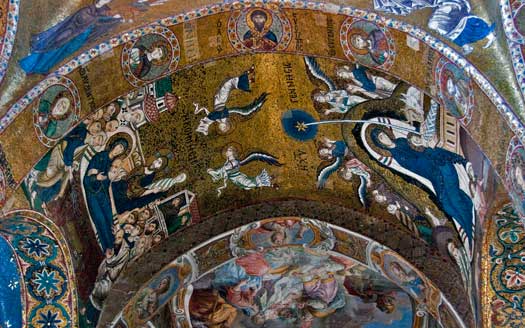
Mosaics depicing the Nativiy (right) and the death of Mary (left)
Unfortunately, it has been marred by some ill-judged Baroque renovations in the 17th century. The sanctuary was torn down, its mosaics destroyed, and was replaced by a much more ornate version, painted with frescoes.

